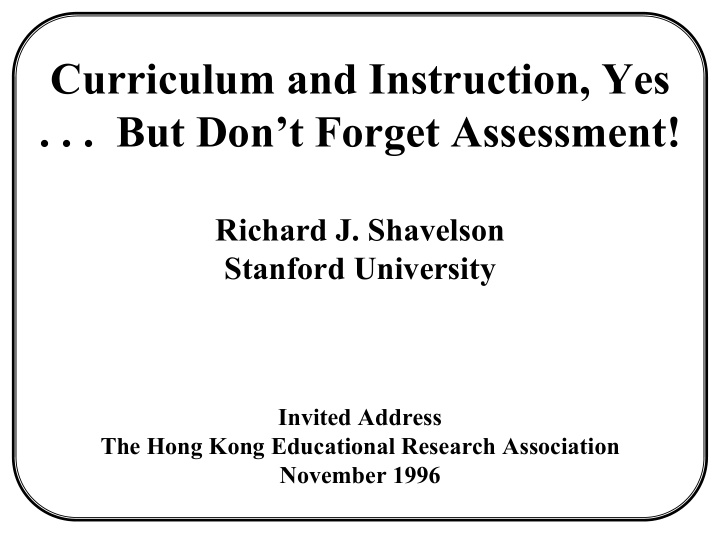



Curriculum and Instruction, Yes . . . But Don’t Forget Assessment! Richard J. Shavelson Stanford University Invited Address The Hong Kong Educational Research Association November 1996
Education Reform Will Be Stimulated by TIMSS There is no one at the helm of U.S. mathematics and science education. In truth, there is no one helm. No single coherent vision of how to educate today’s children dominates U.S. educational practice in either science or mathematics. There is not sin, commonly accepted place to turn to for such vision. The visions that shape U.S. mathematics and science education are splintered Schmidt, McKnight & Raizen (1996, p. 1)
Striking Likeness Among Reform Efforts Curricular reform emphasizes: • Practical learning • Connections both between the sciences and with other subjects • Science and mathematics as ways of knowing • Make mathematics and science more like the content of real mathematics and science, with a community of scholars socially constructing knowledge • Relate mathematics and science to students’ own lives Black & Atkin (1996, p. 32)
Constructivist Reform Emphasizes • Collaboration among students working in groups • Thinking and constructing knowledge for themselves, rather than receiving that knowledge from authority • Working, “hands-on, on concrete problems meaningful to their lives • Applying first and motivating the acquisition of knowledge, recognizing that there is no strict sequence of instruction • Making mathematics, science and technology accessible to the diverse student body found in classrooms in the country by creating learners who are active and responsible for their own learning
Traditional Curriculum And Instruction Emphasizes • Knowing facts should come before using that knowledge • Instruction should be sequenced first to have students receive and memorize, use in routine exercises, and only then to apply this knowledge • Content should be taugh abstractly first and application should be left to later stages in differenct contexts • Motivation should be achieved by external pressures such as examinations and grades, not by changing the nature of instruction • Failure in learning arises not because of poor instruction but because of innate lack of ability or inadequate effort rather than because of the prescribed instructional approach Black & Atkin (1996, p. 62)
But Don’t Forget Assessment! It was striking that the first accounts of most of the innovations in this study made no reference to assessment. In the final reports assessment is central to two of the innovations, but it is virtually ignored in most of the other [23] studies [Black & Atkin, 1996, p. 92].
Sketch of Remainder of Talk • The nature of assessment aligned with constructivist reform, in addition to the usual multiple-choice and short-answer varieties • A brief case study on the romance of curriculum and assessment in the service of this reform in science classrooms • Complementary case studies from the U.S. and Britain on the design of large-scale assessment systems linking curriculum and teaching reform with assessment reform • A post-mortem of these two case studies on what led to their failure • Implications of the failure of the assessment systems for curriculum and instruction reform
Recommend
More recommend